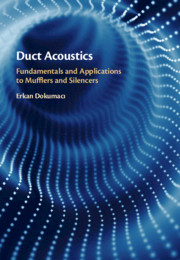Book contents
- Duct Acoustics
- Duct Acoustics
- Copyright page
- Dedication
- Contents
- Preface
- 1 Some Preliminaries
- 2 Introduction to Acoustic Block Diagrams
- 3 Transmission of Low-Frequency Sound Waves in Ducts
- 4 Transmission of One-Dimensional Waves in Coupled Ducts
- 5 Resonators, Expansion Chambers and Silencers
- 6 Multi-Modal Sound Propagation in Ducts
- 7 Transmission of Wave Modes in Coupled Ducts
- 8 Effects of Viscosity and Thermal Conductivity
- 9 Reflection and Radiation at Open Duct Terminations
- 10 Modeling of Ducted Acoustic Sources
- 11 Radiated Sound Pressure Prediction
- 12 Measurement Methods
- 13 System Search and Optimization
- Book part
- Index
- References
12 - Measurement Methods
Published online by Cambridge University Press: 11 May 2021
- Duct Acoustics
- Duct Acoustics
- Copyright page
- Dedication
- Contents
- Preface
- 1 Some Preliminaries
- 2 Introduction to Acoustic Block Diagrams
- 3 Transmission of Low-Frequency Sound Waves in Ducts
- 4 Transmission of One-Dimensional Waves in Coupled Ducts
- 5 Resonators, Expansion Chambers and Silencers
- 6 Multi-Modal Sound Propagation in Ducts
- 7 Transmission of Wave Modes in Coupled Ducts
- 8 Effects of Viscosity and Thermal Conductivity
- 9 Reflection and Radiation at Open Duct Terminations
- 10 Modeling of Ducted Acoustic Sources
- 11 Radiated Sound Pressure Prediction
- 12 Measurement Methods
- 13 System Search and Optimization
- Book part
- Index
- References
Summary
Chapter 12 describes the contemporary measurement methods in duct acoustics. Acoustic measurements are necessary in order to validate theoretical models and also to develop acoustic models when theoretical approaches tend to be inadequate or impossible. The multiple wall-mounted microphone method is introduced from first principles and its applications to the measurement of the characteristics of acoustic sources and of passive system elements are described.
Keywords
- Type
- Chapter
- Information
- Duct AcousticsFundamentals and Applications to Mufflers and Silencers, pp. 501 - 532Publisher: Cambridge University PressPrint publication year: 2021

